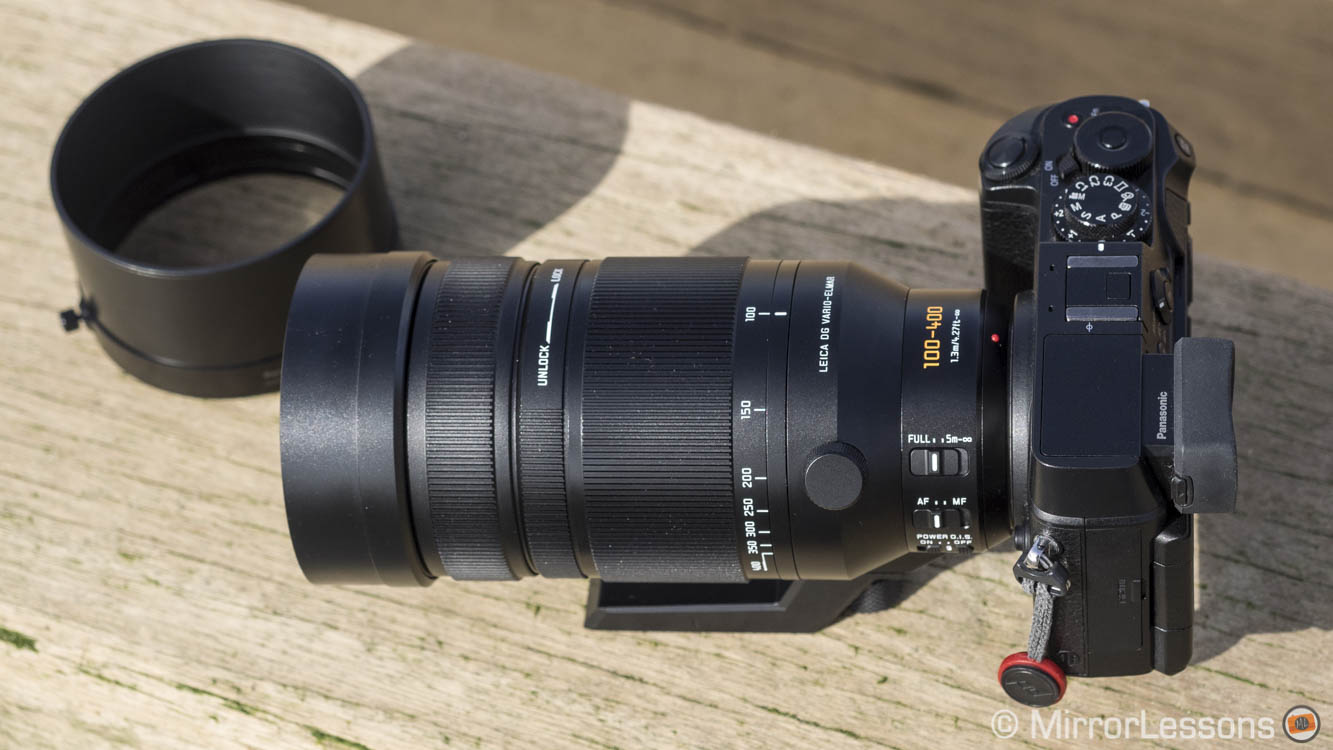Have I already mentioned that 2016 is the year of super telephoto lenses? You might start to find me repetitive but the truth is that I am only halfway through the camera/telephoto lens combinations I am excited to try this year for wildlife photography.
After putting the Olympus 300mm f/4 Pro through its paces, we now turn to another highly anticipated lens for Micro Four Thirds. At first, the Panasonic/Leica 100-400mm f/4-6.3 may seem like just another zoom lens with a slow, non-constant aperture that delivers sufficient performance but nothing more.
However, it turns out that this lens is a high quality product. It often managed to surprise me in cases where my expectations weren’t very high, especially concerning the sharpness at the fastest aperture and longest focal lengths. And that’s not all.
Is the Panasonic 100-400mm a worthwhile investment despite the slow aperture and high price? Let’s find out!

Click on the image to open the full res version.

Click on the image to open the full res version.

Leica DG Vario-Elmar 100-400mm f/4-6.3 APSH Power O.I.S. Main Specs
- Focal length: 100-400mm
- Focal length (equiv. 35mm): 200-800mm
- Maximum aperture: 4
- Minimum aperture: 6.3
- Number of aperture blades: 9 circular aperture diaphragm
- Angle of view: 12 ‑ 3.1°
- Closest focusing distance: 130cm
- Lens configuration: 20 elements / 13 groups
- Special elements: 1 Aspherical ED, 1 EUD, 2 ED elements
- Lens surface coating: None
- Maximum image magnification: 0.25x / 0.5x (35 mm camera equivalent)
- Optical Image Stabilizer: Yes (POWER O.I.S.)
- Dimensions: φ83, 171.5 mm
- Filter diamater: 72mm
- Weight: 985g (excluding lens cap, lens rear cap, lens hood and tripod mount)
[toc heading_levels=”3″]
Below you can also watch our video review of the lens.
Design and ease of use
Editor’s note
The sample we received to review is a final version as far as optical quality is concerned, but the exterior is pre-production and as such, it had a few defects:
- the zoom ring is hard to rotate
- the lock ring doesn’t lock perfectly
- the built-in slide ring for the hood moves too easily when not in use
The only thing that annoyed me during the testing period was the stiff zoom ring. Panasonic assured us that these issues won’t be present in the final version of the lens. We will check a final sample of the lens as soon as possible to confirm this.
The Leica DG Vario-Elmar replicates the build quality seen from other Leica branded lenses for Micro Four Thirds such as the Nocticron 42.5mm f/1.2. The all-metal barrel gives that reassuring feeling of a premium high quality lens. It is weather sealed against dust and water but not freeze proof.
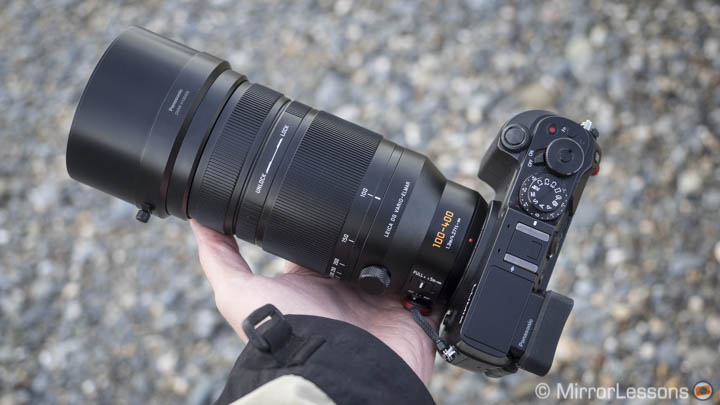
The 100-400mm weighs almost 1kg but it isn’t too front-heavy. It remains comfortable to use on the GX8 and the E-M1 especially. The lens is acceptably compact if we think about the zoom range it offers. Note that the zoom mechanism is not internal so the lens protrudes quite a lot (almost double the length) when zooming in.
[twentytwenty]
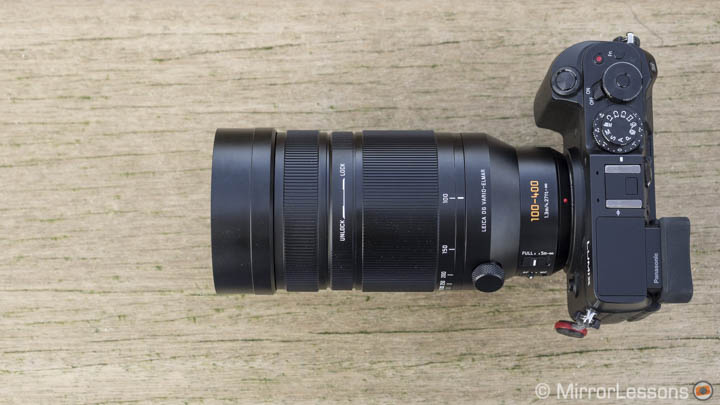
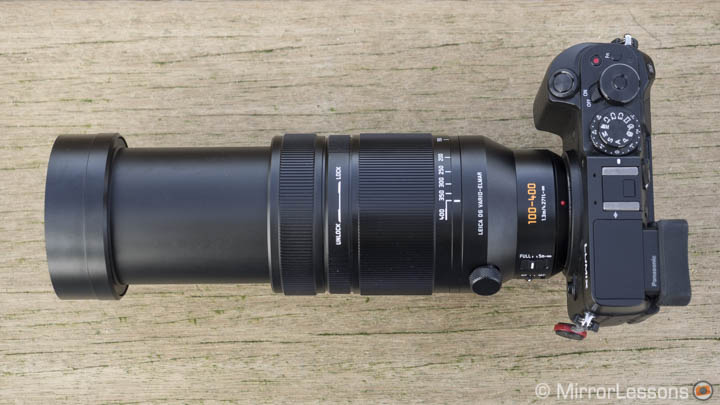
[/twentytwenty]
There are three rings on the lens. In addition to the zoom ring, there is the focusing ring that is of course a “fly-by-wire” type. I found it smooth and precise to use for both stills and video shooting. Then we have the lock ring to prevent the zoom ring from rotating. You can use it at any zoom position if you want to work at a fixed focal length.
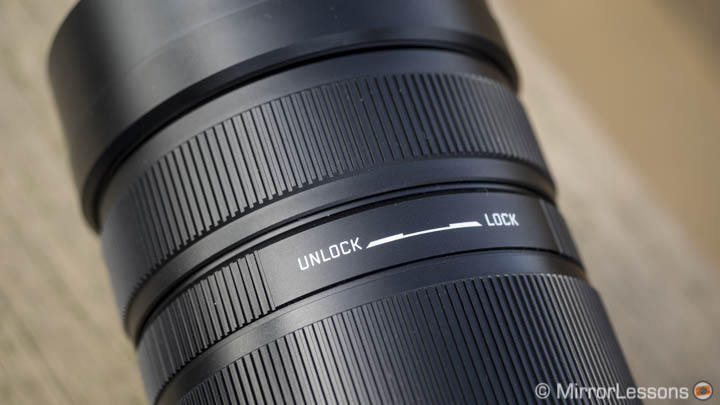
On the side of the barrel we find three switches:
- The first starting from the top can limit the shortest focus distance to 5m instead of 1.3m;
- The second switch allows you to quickly change from autofocus to manual focus;
- The third switch activates or deactivates the optical stabilisation.
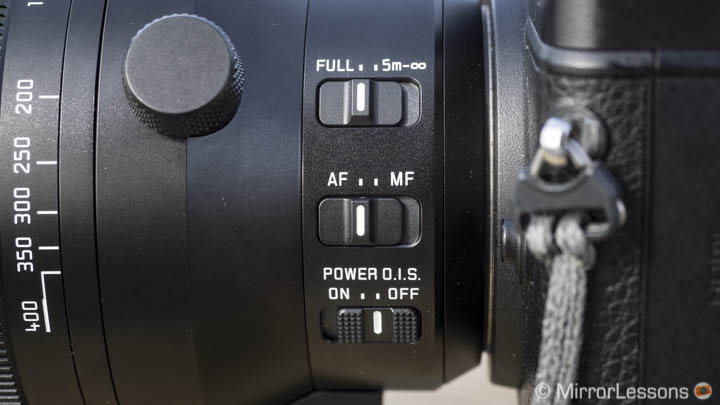
Personally I really appreciated the tripod mount mechanism.
The collar is built-in and can’t be removed. In fact the three switches mentioned above are located right on it. By turning the dedicated lock knob, you can rotate the collar 45° to put the camera in landscape or portrait orientation. This means that the three switches always remain in the same position on the left-hand side.
[twentytwenty]
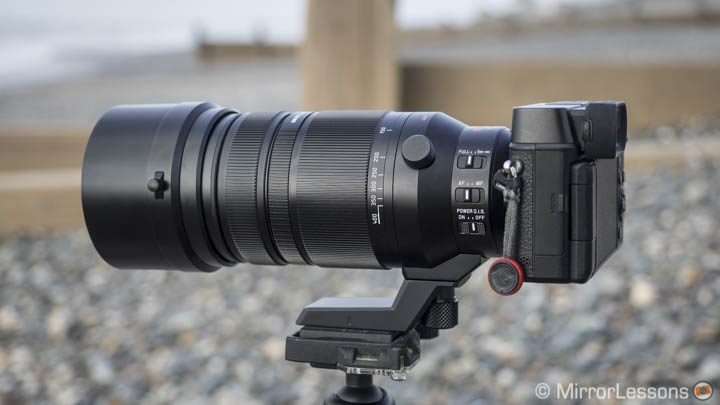
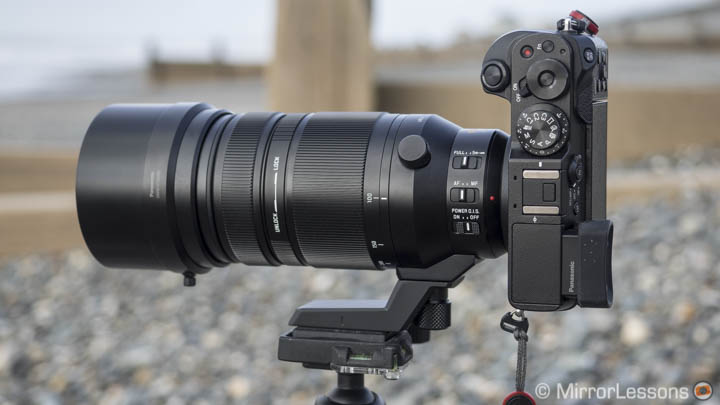
[/twentytwenty]
The tripod mount can be detached from the collar. This solution also makes the whole package more compact even with the tripod mount attached.
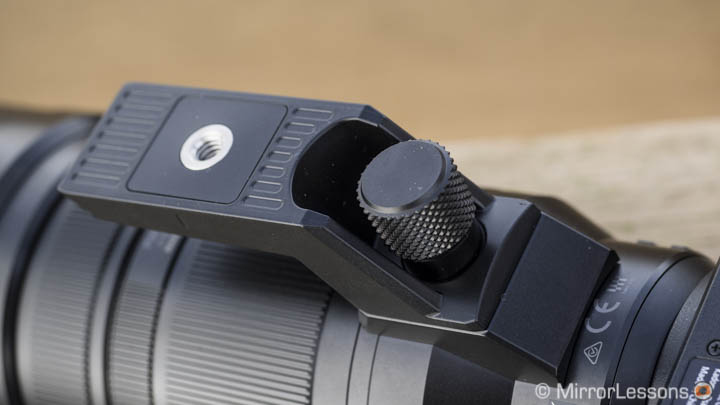
The lens hood is made of metal. You attach it to the built-in slide ring positioned at the front end of the lens. Once mounted, you can slide the hood forward or backward depending on you needs. The difference between the two positions is not huge though, so I admit I found this extra option unnecessary. I would have preferred a sliding hood like the one found on the Olympus 300mm Pro.
[twentytwenty]
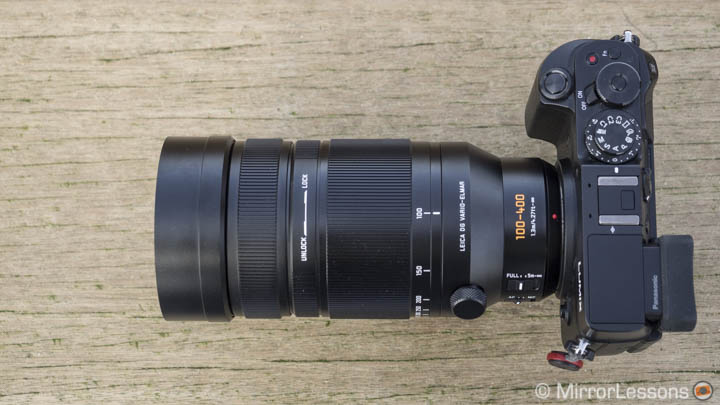
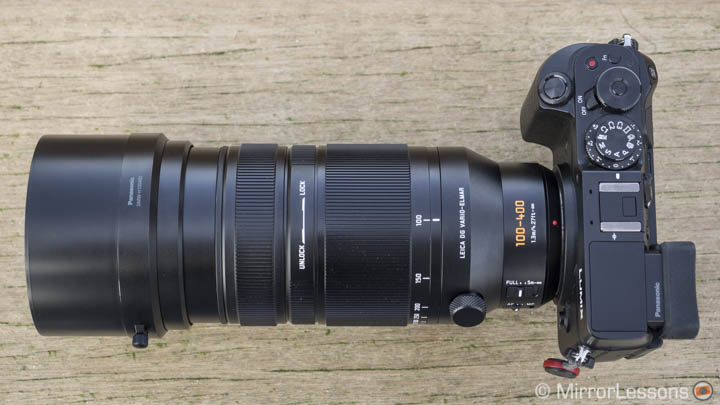
[/twentytwenty]
Through the lens: optical quality
The Pana/Leica 100-400mm f/4-6.3’s optical quality and sharpness surprised me.
Leica designed the lens to give the best performance at the fastest apertures regardless of the focal length. In addition to the various images I took at natural reserves around Wales, I ran a home-made test to confirm my findings. I got a little help from the lovely stuffed kite below: his name is Milvus! Yes, I bought a stuffed animal but for a good cause: it supports the Bwlch Nant yr Arian Forest Visitor Centre!
At 100mm, the difference between f/4 and f/5.6 is barely noticeable. At 400mm a similar conclusion applies: f/8 is just a tiny bit sharper than f/6.3 at moderate distances and you will need to pixel peep at lot to find a difference. With more distant subjects f/8 gives slightly better sharpness too.

Click on the image to open the full res version.

Click on the image to open the full res version.
[twentytwenty]


[/twentytwenty]

Click on the image to open the full res version.

Click on the image to open the full res version.
[twentytwenty]


[/twentytwenty]
In fact I never hesitated to use this lens wide open and the results are great. The same findings apply to the 200mm and 300mm focal lengths and the various apertures. Past f/8 diffraction starts to appear but sharpness remains decent up to f/16.
I ran another test at 300mm and 400mm to see if there was a difference in sharpness between the two focal lengths. I took the same shot by readjusting my distance to get the same composition. I noticed that the lens performs slightly better at 300mm than at 400mm. Here again the difference is not huge but worth mentioning.

Click on the image to open the full res version.

Click on the image to open the full res version.
[twentytwenty]


[/twentytwenty]
Note: you can check a full set of images shot at all apertures and focal lengths here.
For me, 400mm remains very usable. For a real world shoot, you’ll often zoom in completely, which magnifies the subject and the minute details on its body.

Click on the image to open the full res version.

Click on the image to open the full res version.
The out of focus background and bokeh are not perfect but I wasn’t expecting anything more from this type of lens. Still, in my own personal opinion, I find some shots rather nice. You can come across double lines and harsh edges in some cases but most of the time, I was pleased with the results I got.

Click on the image to open the full res version.

Click on the image to open the full res version.

Some double images and hard edges in the bokeh can be noticed in this example
Click on the image to open the full res version.
The lens is not designed for portraits of course but the performance is not bad for some occasional head shots. This shows once again the versatility of the lens.

The lens can focus as close as 1.3m through the whole zoom range which gives you a magnification factor of 0.25x (0.5x by 35mm format equivalence) at 400mm. You can see an example below with Milvus and then a few real world shots. To give you an idea, Milvus’s body measures approximately 17cm. Sharpness decreases slightly when focusing at the shortest distance.

Click on the image to open the full res version.

Click on the image to open the full res version.

Click on the image to open the full res version.
If you look for it, you can find some flare but it is rare that you will have to deal with it unless you are shooting directly in the sun. Panasonic doesn’t mention any particular coating and as you can notice below, I encountered some greenish ghost flare and some slight purple veiling flare.

The lens controls chromatic aberration and vignetting very well, so much that I haven’t found anything in particular worth mentioning. Vignetting is noticeable at f/6.3 and 400mm mostly but it easy to fix it. The lens is also almost completely distortion-free.
Autofocus
I tested the lens on both the Lumix GX8 and Olympus OM-D E-M1. The AF motor behaved well on both cameras. It is fast and silent. For birds in flight I found that limiting the focus distance to 5m-∞ with the dedicated switch helps to achieve more accurate results. Unless you need to focus closer, I suggest that you leave it like this.
With both cameras I got an average of a 50% keeper rate. At least 10/15% was my fault because I didn’t track the birds very well (I am not an experienced bird photographer yet).

Click on the image to open the full res version.
E-M1 users will be pleased to know that it is the camera that gave me the most constant results thanks to the phase detection points that work in Continuous-AF. Once it locks onto the bird, it rarely loses it except when I wasn’t good enough at tracking the subject in the first place.

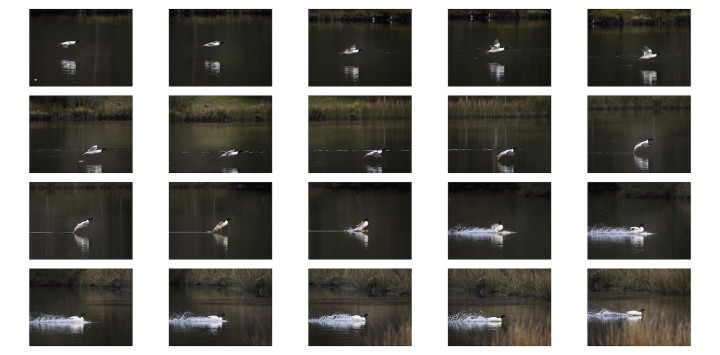
However there were multiple occasions when the camera failed to lock, leaving me with a series of out-of-focus shots (even when set to Focus priority).
OM-D E-M1 favourite settings for birds in flight:
- Continuous AF
- Continuous shooting H (9fps)
- Focus Priority
- 9-target AF points when the bird is closer to the ground
- Multi-Target AF when the bird is in the sky

Click on the image to open the full res version.

Click on the image to open the full res version.
With the GX8, I had less constant results. Despite the lens being compatible with the 240fps AF drive, the DfD contrast detection system struggles especially when the bird is in the sky. The camera often alternates between sharp and out-of-focus shots. Photographing birds in flight is probably one of the toughest AF tests for any camera and in this case, it reveals a limit of the DfD technology in my opinion.
Lumix GX8 favourite settings for BIF:
- Continuous AF
- Continuous shooting M (because it keeps the live view)
- Custom AF with 9 central points
- Focus priority
Optical stabilisation
The 100-400mm features Panasonic’s Power O.I.S. system. I ran some tests with Milvus once again to see how slow a shutter speed I could use with the Dual IS system of the Lumix GX8 that combines sensor and optical stabilisation.

At 100mm I managed to shoot at 1/5s with good results. The sharpest result I got at 400mm was at 1/15s while I got an almost perfect image at 1/10s with the longest focal length. This is not bad at all considering the 800mm equivalent! However the keeper rate went up significantly only when I started to shoot at 1/50s.
In the real world at 300mm or 400mm, I would advise that you stay at 1/200s at least. If you can raise the speed to 1/400s, all the better. Also keep in mind that the GX8 suffers from some severe shutter shock between 1/50s and 1/320s and the only way to solve this is to use the electronic shutter, which also helps with slow shutter speeds.

Here I got a perfect result at 1/100s but I took the shot multiple times and only a few were perfectly sharp.
Click on the image to open the full res version.
Then I tested the lens on the E-M1 by turning off the sensor stabilisation to see how effective the OIS would be on its own. Remember that the stabilisation system of Olympus bodies and Panasonic lenses can’t be combined. You can also leave the IBIS on and activate the Lens OIS Priority in the Menu (C. Release).
Interestingly I got very similar results on the Olympus camera with optical stabilization only. I managed to capture one sharp shot at 1/15s and the keeper rate went up from 1/50s here as well.

The fact that I had very similar results with the E-M1 is related to two things in my opinion. First, I find the ergonomics of the Olympus camera better than those of the Panasonic, meaning you are less likely to quiver when you press the shutter release button. This may seem like a small detail but when you are shooting at 400mm (800mm equivalent on 36×24 format), every little thing that can improve the shooting experience counts. I am confident that the ergonomics of the Lumix GH4, for example, would also be a better match for this specific test.
Second, I also think that the Dual IS of the GX8 tends to use the optical stabilization more when at extreme focal lengths.
With the OM-D series, you also have the option of using the 5-axis sensor stabilisation instead. At shorter focal lengths the IBIS has an advantage over the optical stabilisation (1EV of difference more or less). At the longer focal lengths, the lens O.I.S. gives you slightly better results.

For video, the Power OIS is effective but I noticed some jittering at the longest focal lengths. It is more visible with distant subjects. Note that to get acceptable results at the longest focal lengths, you will need at least a monopod in combination with the OIS.
If you plan to shoot 100% steady images at 400mm, you will need a robust video tripod with a strong fluid head. At that focal length, even the tiniest movement or some wind can produce shaky footage.
Below you can check out some 4K footage shot with the GX8 with the Power O.I.S. activated and a monopod.
Conclusion
I’ll say it up-front: the Panasonic 100-400mm really surprised me. I wasn’t expecting the lens to be that sharp at all focal lengths and the fastest apertures. Although I used 300mm and 400mm most of the time for my wildlife photos, I also found it helpful to be able to pull back to 100mm. It can be an excellent choice not only for birds and wildlife but also for outdoor sports and other applications where a long lens is required.



The only real limit you will find for a real world shoot with this lens is the slow aperture of f/5.6 and f/6.3.
Unless it is a sunny day, you will need to raise your ISO to 1600 or even 3200 to catch birds in flight because you need a very fast shutter speed to ensure sharpness. Things gets better with static subjects but if you are in the shade, you won’t be able to keep your ISO at 200 anyway.
Whether this is acceptable or not is up to you. Personally I’ve stopped worrying about pushing my ISO too far with Micro Four Thirds, as I find the results more than acceptable (and remember that a good exposure is always better than recovering in post). It won’t beat a DSLR with a larger sensor in terms of IQ or AF but as usual, you get the advantage of a lighter kit.

What can be discouraging is the price but if you look at other 100-400mm lenses like the recent Fujifilm version or the Canon version, you will notice that the price isn’t so different. (Actually the Pana/Leica is slightly cheaper.) So yes, the lens is expensive but it is also an excellent performer.
Lately there seems to be the tendency to reject these lenses because they are “too expensive for Micro Four Thirds.” The same reasoning was applied to the Olympus 300mm f/4 Pro but I feel it is mainly a matter of perspective. These lenses have been designed for the same purpose for which Fujifilm, Canon and Nikon designed theirs. The 100-400mm’s price is in line with the other lenses and the Olympus 300mm could actually be considered cheaper than its DSLR counterpart.
Is the Pana/Leica 100-400mm worth the money? Well, the truth is that it might be the best middle ground you can find right now for the M4/3 system.

It is significantly sharper than the Lumix 100-300mm (see our comparison here) and it is less expensive than the Olympus 300mm Pro. The latter retains some worthy advantages in my opinion (faster, slightly sharper, better IS) and is probably the ultimate lens you can buy for your wildlife photography.
However, the 100-400mm offers an unprecedented level of versatility that can make it the optimal choice for photographers who want to get more serious about the wildlife genre but don’t have enough experience (or the budget) for the Olympus prime lens.
 What I like about the Leica DG Vario-Elmar 100-400mm f/4-6.3 ASPH Power O.I.S.:
What I like about the Leica DG Vario-Elmar 100-400mm f/4-6.3 ASPH Power O.I.S.:
- Premium “all-metal” build quality
- Smart tripod collar and tripod mount mechanism
- Great optical performance at all focal lengths and fastest apertures
- Fast autofocus motor
- Excellent optical stabilisation
 What I don’t like about the Leica DG Vario-Elmar 100-400mm f/4-6.3 ASPH Power O.I.S.:
What I don’t like about the Leica DG Vario-Elmar 100-400mm f/4-6.3 ASPH Power O.I.S.:
- The sliding ring for the hood doesn’t give a substantial advantage
- The slow aperture at 300 and 400mm will require you to raise your ISO very often
- Optical stabilisation produces some jittering in video footage
- The Dual IS system with the GX8 doesn’t give a substantial advantage
Reminder: you can also check out more sample images here.
